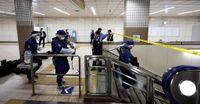Japan's airports are facing significant operational challenges as the country gears up to welcome more international tourists. Experts have pointed out that the chaos at Japanese airports highlights structural inefficiencies, outdated procedures, and bureaucratic hurdles that hinder the flow of travelers. Despite Japan's ambition to reach 60 million tourists annually by 2030, many international visitors are expressing fatigue over long immigration lines, overcrowded attractions, and a surprising lack of public trash cans.
According to a recent survey by the Japan Tourism Agency (JTA), over half of the respondents reported having a smooth travel experience. However, some voiced concerns regarding infrastructure and service issues at airports and tourist destinations. Japan is on track to exceed 40 million foreign visitors by 2025, an increase from last year's record of 36.9 million.
Ashley Harvey, a tourism marketing analyst with over 15 years of experience in Japan's tourism sector, explained that the airports have not implemented flexible procedures despite their goal of accommodating a large influx of visitors. "Part of the problem is that airports haven't adopted flexible procedures, even though they aim to host a significant number of tourists annually," Harvey stated.
In contrast, countries like Singapore and Dubai have streamlined their processes by allowing travelers to pre-register and use automated immigration counters for quicker processing. At Japanese airports, however, passengers are still subjected to lengthy temperature checks, immigration, and customs procedures.
Officials have acknowledged a surge in arrivals at Japan's main international airports. On May 5, 2025, Mainichi reported that flights were arriving at an average rate of every two minutes, double the pace of 2024. Passengers have been seen queuing for about 500 meters, with some waiting up to two hours for processing—longer than during the pandemic when additional health checks were in place.
Japan has separate lanes for returning citizens and tourists, but the daily procedures remain slow. Naomi Mano, CEO of Luxurique, a high-end domestic travel agency, believes that a lack of government oversight contributes to the ongoing issues. "All the different airports are managed independently by semi-governmental agencies with different operational methods," Mano remarked. She recently traveled through Narita Airport, where the procedures seemed efficient, but she noted that this cannot guarantee the same experience at Haneda Airport.
The JTA is currently investigating tourist complaints, which are expected to have significant implications moving forward, but Mano indicated that it may take at least three more years for improvements to be fully implemented.
In the JTA survey, 8.6% of participants expressed frustration with long immigration lines, while 15% reported difficulties due to language barriers. Additionally, 13.1% were dissatisfied with overcrowded tourist spots, and 21.9% wished for more public trash cans. Most trash cans were removed from train stations in 1995 as part of efforts to maintain public hygiene. Tourists are often surprised to find almost no public trash cans on Japanese streets.
Despite this, Mano pointed out that the absence of trash cans is a cultural difference that many foreign visitors come to appreciate. "In Japan, we take our trash home instead of leaving it for someone else to clean up, and when our guests realize this, they become more aware of their own habits," she explained. Many tourists have remarked that Tokyo and Kyoto are among the cleanest cities they have ever visited.
Meanwhile, Japan is grappling with rising concerns over public safety following a series of random attacks. On May 9, 2025, a knife attack occurred in Osaka, where a man in his 30s was injured near his workplace's parking area. The victim was hospitalized with minor injuries, and police arrested a 34-year-old unemployed man living in the same apartment complex. The suspect admitted to punching the victim and using a knife from his home, stating he was unsure if he intended to kill him.
Just two days earlier, on May 7, a similar incident unfolded at Todaimae Station in Tokyo, where 43-year-old Toda Yoshitaka was arrested for attempted murder after attacking two passersby with a knife. A knife measuring about 20cm was recovered at the scene. The two victims were conscious when taken to the hospital, and both reported not knowing the suspect.
Since late 2024, random attacks in Japan have been on the rise, raising alarms among citizens and officials alike. On May 1, 2025, a 28-year-old man drove his car into a group of elementary school children in Osaka, injuring several youngsters.
Kiyoe Naho, a crime prevention expert at the STEP Comprehensive Research Institute, commented on the challenges of preventing random attacks in public spaces. "It's difficult to completely prevent random attacks in public places," Naho said. She urged people to stay vigilant by avoiding phone use while walking, not wearing noise-canceling headphones, and using bags or umbrellas to shield their bodies in emergencies.
Naho also noted that such attacks often stem from individuals who feel isolated and frustrated, seeking an outlet for their anger. To mitigate these risks, she emphasized the need for Japan to focus on supporting isolated individuals and fostering a more inclusive social environment to address the root causes of crime.
As Japan prepares to welcome millions of tourists, the nation faces the dual challenge of enhancing airport efficiency while ensuring public safety. The road ahead will require concerted efforts from authorities, tourism agencies, and the community to create a seamless experience for visitors and a secure environment for all.




